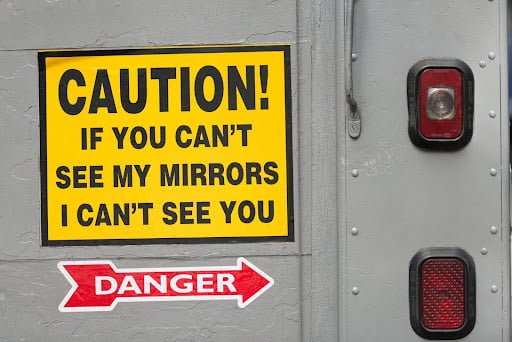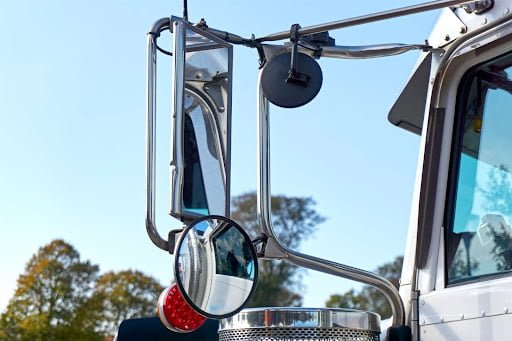What Makes a Truck’s Blind Spots More Dangerous?
Blind spots on tractor-trailers are more dangerous than those on smaller vehicles for many reasons, including:
- The substantial length and height of tractor-trailers create larger blind spots that can easily envelop surrounding vehicles. A car positioned in these areas is virtually invisible to the truck driver, making accidents more likely, particularly when the truck is turning, changing lanes, or stopping.
- Tractor-trailers typically lack a rearview mirror, leaving the area immediately behind the truck as a significant blind spot.
- Truck drivers must heavily rely on side mirrors, but even these mirrors have limitations and cannot capture the entire area beside and slightly behind the truck.
- Limited visibility means that even with cautious driving and regular mirror checks, a truck driver may not be able to see vehicles in these blind spots.
Others on the road need to be particularly mindful of their position relative to a truck in order to protect themselves from a truck accident.
Where Are a Tractor-Trailer’s Blind Spots?
Tractor-trailers have four main blind spots:
1. Blind Spot Directly in Front
The blind spot directly in front of a tractor-trailer is often underestimated but is particularly dangerous. This blind spot can extend approximately 20 feet in front of the truck. Due to the elevated position of the truck cab, drivers may not see vehicles that are too close to the front bumper. This lack of visibility is especially risky in slow-moving traffic and when cars abruptly change lanes and cut in front of a truck. A sudden stop by the truck can lead to a severe collision if a vehicle is within this blind spot, as the truck driver may not have enough time to react.
2. Blind Spot Directly Behind
The area directly behind a tractor-trailer is a substantial blind spot that extends up to 200 feet. This blind spot prevents the truck driver from seeing vehicles that follow too closely. Tailgating in this zone is particularly hazardous, as the driver of the following vehicle won’t have enough time to react if the truck stops suddenly. Additionally, it makes the trailing vehicle invisible to the truck driver, who may change speed or make maneuvers without awareness of the vehicle behind.
Remember, Massachusetts law states that a “driver of a vehicle shall not follow another vehicle more closely than is reasonable and prudent”. When it comes to big trucks, giving more distance than usual is the best way to stay safe and within the law.
3. Blind Spot Alongside the Driver’s Side
The blind spot on the driver’s side of a tractor-trailer extends along the left side of the truck. It typically starts from the cab and stretches back along the length of the trailer. This blind spot makes it difficult for truck drivers to see vehicles that are directly beside the cab or immediately next to the trailer. It is particularly risky when trucks make left turns or change lanes to the left, as vehicles in this blind spot may be completely hidden from the truck driver’s view.
4. Blind Spot Alongside the Passenger’s Side
Arguably the most dangerous of the blind spots, the area alongside the passenger’s side of a tractor-trailer is the largest. It extends diagonally and can cover several lanes to the right of the truck. This blind spot is especially dangerous because vehicles can remain unseen for a prolonged period while driving alongside the truck.

How To Avoid a Truck’s Blind Spots
Avoiding blind spots on tractor-trailers helps ensure your safety and the safety of others on the road.
The key is to remain visible to the truck driver at all times. This means keeping a safe distance from tractor-trailers, giving you and the truck driver enough time to react to traffic changes.
When driving near a truck, avoid staying alongside it for too long, as you may be in a blind spot without realizing it. When passing a truck, do it quickly and safely, ensuring you’re visible in the truck’s side mirrors before making your move. Remember, if you can’t see the truck driver’s face in their side mirror, they likely can’t see you.
Who’s Responsible for a Blind Spot Trucking Accident in Massachusetts?
Determining responsibility in a blind spot trucking accident in Massachusetts can be complicated. While truck drivers are required to check their blind spots and be cautious when changing lanes, other drivers also have a responsibility to drive safely around large trucks.
In the event of an accident involving a truck’s blind spot, determining liability often involves examining the actions of both the truck driver and the other involved drivers. Factors like whether the truck driver followed safety protocols or if the other driver was aware and respectful of the truck’s blind spots are considered. It’s important to recognize that both parties have a role in preventing these types of accidents and may share responsibility if an accident occurs.
Jim Glaser Law Has the Answers to Your Questions
If you find yourself involved in a truck accident in Massachusetts, particularly one related to blind spots on tractor-trailers, Jim Glaser Law is here to help. We understand that dealing with the aftermath of a truck accident can be overwhelming, which is why we offer dedicated and compassionate legal support. Our team will guide you through the legal process, helping you understand your rights and the best course of action for your specific situation.
With Jim Glaser Law, you’ll have a truck injury attorney committed to fighting for your rights and helping you navigate the complexities of your case. Contact us for a free consultation to explore your options and learn how we can assist you in seeking justice and fair compensation.











